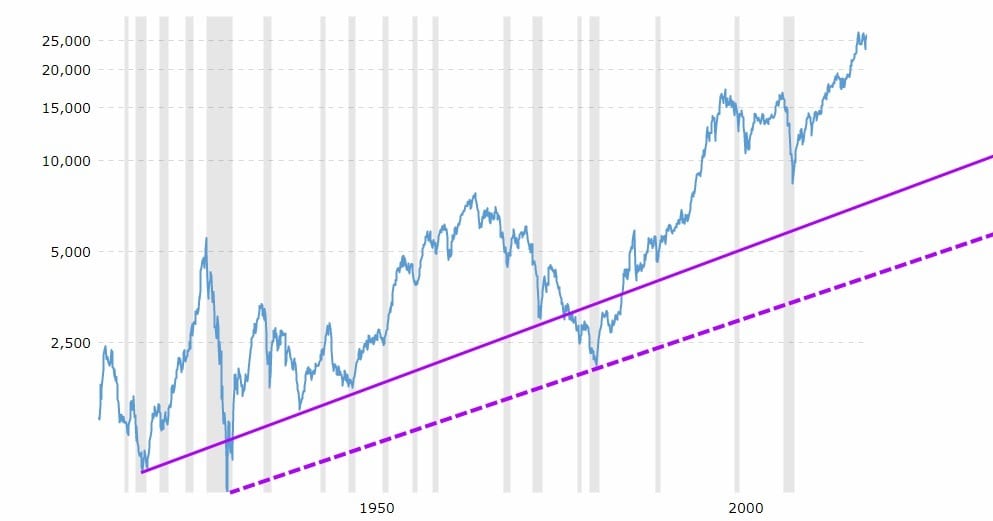Editor: Vladimir Bajic | Tactical Investor
Unlocking Contrarian Gains: Best Shares to Buy Now!
Updated Dec 26, 2023
First and foremost, it’s wise to disregard the prophets of pessimism and self-proclaimed fortune-tellers of the future, for they all echo a common refrain. They tend to dwell on hypothetical scenarios, painting pictures of impending financial storms. However, it’s essential to recognize that the market is destined to encounter significant pullbacks, perhaps even labelled as crashes. Yet, the unwavering truth persists: markets possess an innate resilience, continually rebounding and charting an upward trajectory. If you align with the camp of long-term optimism, often called “Perma bulls,” you’ll find prosperity on this journey. In contrast, those who perpetually bear a pessimistic outlook, known as “permabears,” may not fare as favourably.
The Power of Resilience and Optimism
In investing, it’s crucial to remember that the market, much like life itself, is a series of ups and downs. It’s a rollercoaster ride that can be thrilling, terrifying, and everything in between. But, as history has shown us, the market has an uncanny ability to bounce back, even from the most devastating crashes. This resilience is a testament to our economic systems’ enduring strength and adaptability. It’s a reminder that, despite the doom and gloom surrounding discussions about the market, there is always a reason for optimism.
The market’s resilience is not unlike the strength of the human spirit. Just as we have weathered countless storms throughout history, from wars to depressions, the market has also weathered its own storms. This resilience is a testament to the power of optimism and the belief in a better future. It’s a reminder that, even in the face of adversity, we can rise above and forge ahead.
Investing is not a sprint; it’s a marathon. It requires patience, discipline, and a long-term perspective. Those who can maintain this perspective see beyond the short-term fluctuations and focus on the long-term trends often reap the most significant rewards. This is the essence of being a “Perma bull” – maintaining an unwavering belief in the market’s upward trajectory, even in the face of temporary setbacks.
On the other hand, those who are constantly pessimistic and always expect the worst often miss out on the market’s opportunities. These “permabears” are so focused on the potential for disaster that they fail to see the growth potential. They are so consumed by fear that they cannot seize the opportunities that come their way.
Navigating the Seas of Investment
Embarking on the investing journey is similar to setting sail on a vast, unpredictable ocean. You are the captain of your own ship, steering it through calm waters and turbulent storms, navigating through the unpredictable currents of the market. Your compass is your knowledge, your ship is your investment portfolio, and your destination is financial prosperity.
As you sail, you will encounter various investment opportunities with unique potential and risks. These islands dot your path – opportunities to explore, learn, and grow. Among these islands, you will often find the ‘best shares to buy now,’ which promise great rewards and demand careful navigation. The decision to dock at these islands to invest in these shares is a calculated one. It requires a deep understanding of the market, the company you’re investing in, and the overall economic climate.
Investing is not a static process. It is as dynamic as the market itself, constantly evolving and demanding adaptability. Each investment and each decision made is a learning opportunity. It provides invaluable insights into the market’s behaviour, different industries’ performance, and the impact of global events on investment outcomes.
The path to prosperity is paved with both successes and failures. Sometimes, your decisions yield significant returns, affirming your strategies and boosting your confidence. Conversely, there will be times when your investments do not perform as expected. But these are not failures; they are stepping stones, lessons that contribute to your growth as an investor.
The journey to investment prosperity is not a smooth one. It is fraught with challenges, uncertainties, and risks. But it is in navigating these rough waters that resilience and optimism become your best allies.
Resilience allows you to weather the market’s storms and remain steadfast when your investments underperform, or the market fluctuates. It encourages you to view these instances not as setbacks but as opportunities for reassessment and growth.
Optimism, on the other hand, keeps you anchored in your belief in the market’s potential. It helps you see beyond the immediate fluctuations and focus on the long-term trends. It reminds you that the ‘best shares to buy now’ align with your long-term investment goals and strategies, not just those that promise immediate returns.
As you continue this journey, remember that your path to prosperity is not predefined. It is created with each decision you make, each risk you take, and each lesson you learn. Stay resilient, stay optimistic, and keep your eyes on the horizon. The journey to investment prosperity is remarkable, filled with invaluable experiences and enduring rewards.
Discover the Best Shares to Buy Now: Riding the Trend to Success
Navigating the intricate landscape of investments requires more than just financial acumen; it demands a profound grasp of mass psychology and a strategic approach to contrarian investing. In finance, understanding these concepts can be the linchpin differentiating between prosperous wealth accumulation and financial tumult.
Diving further into this realm, it becomes evident that the allure of short-term trends often distracts investors from the timeless wisdom of focusing on the best shares for long-term growth. Like a chessboard, the stock market requires strategic moves that anticipate the long game rather than impulsive reactions to fleeting maneuvers.
In this strategic dance of wealth creation, it’s imperative to identify the best shares to buy now—twice emphasizing the significance of this endeavour. These shares should not merely mirror current market fads but stand as resilient pillars capable of weathering the storms of economic fluctuations. By adopting a perspective transcending the immediate horizon, investors position themselves to ride the trend to success, aligning their portfolios with enduring value rather than ephemeral market euphoria.
In essence, the key to financial triumph lies not in chasing after the transient but in discerning the enduring opportunities that the market presents. Mastering this art, much like a grandmaster in chess, allows investors to navigate the complexities of finance with an intelligent approach, ensuring that their moves stand the test of time.
Understanding Mass Psychology in Investing
Mass psychology studies how human emotions and behaviour influence financial markets. It’s a fascinating field because it helps us grasp the dynamics of crowd behaviour in the investment world. One fundamental aspect of mass psychology is recognizing that markets often swing between extremes of optimism and pessimism.
Mass psychology plays a significant role in decision-making when it comes to investing. It’s human nature to follow the crowd, especially when the public makes substantial profits. This behaviour is driven by the fear of missing out (FOMO) and the desire for quick gains. When most investors become overly optimistic and euphoric about the market’s prospects, it often signals a peak in sentiment. This is when mass psychology reaches a boiling point, which can be a warning sign for savvy investors.
Contrarian investing, on the other hand, takes a different approach. Contrarians believe it’s time to be cautious when the crowd is overwhelmingly bullish and euphoric. They take positions opposite to the crowd, betting on a market correction or reversal. Contrarians thrive on the idea that markets tend to overreact to news and events, creating buying or selling opportunities.
Navigating Contrarian Investing: Unveiling the Value and Identifying the Best Shares to Buy Now
Delving into contrarian investing unveils a strategic approach that thrives on rationality in the face of market irrationality. Contrarian investors are not perpetual bears; rather, they are astute individuals who comprehend that, in the short term, markets are steered by emotions and sentiment. This distinctive philosophy involves seizing opportunities amid panic and exercising disciplined restraint when others succumb to greed.
Contrarian investing positions itself as a beacon of wisdom during tumultuous market conditions, offering a unique advantage: the prospect of acquiring assets at a discounted price. In the throes of market panic, when others are hastily selling, contrarians step in with a discerning eye, identifying undervalued stocks poised for future growth. This patient and calculated approach, akin to a chess master contemplating each move, often culminates in substantial gains as the market inevitably regains its equilibrium.
In the grand tapestry of financial strategy, contrarian investing emerges not as a contrarian for the sake of opposition but as a strategic maestro, orchestrating moves that capitalize on the oscillations of market sentiment. In this careful dance between panic and restraint, the true value of contrarian investing manifests, paving the way for prudent investors to navigate the unpredictable seas of finance with resilience and foresight.
The Best Shares to Buy: Long-Term Perspective
Let’s focus on finding the best shares to buy in the long run. It’s crucial to understand that successful investing is not about timing the market perfectly or chasing the hottest trends. Instead, it’s about identifying high-quality companies with solid fundamentals with the potential for long-term growth.
The right time to buy these shares is often when the markets have experienced substantial corrections or crashes. These moments of market turmoil create opportunities to purchase great companies at discounted prices. Instead of fretting over short-term market fluctuations, long-term investors should view these events as a chance to accumulate quality assets.
Timing the Market: When to Buy Shares
Investing in the stock market is not just about buying low and selling high. It’s about understanding the market dynamics, the company’s fundamentals, and the broader economic environment. When the market crashes or corrects powerfully, it’s often due to a significant change in these factors. Therefore, it’s crucial to understand why the market is falling before deciding to buy.
One of investors’ most common mistakes is trying to time the market based on short-term fluctuations. This approach is not only risky but also ineffective in the long run. Instead, investors should focus on the long-term trends and the intrinsic value of the companies they invest in.
When the market is in a state of panic, it’s easy to get caught up in the fear and sell off shares. However, this is often the worst time to sell. Instead, it’s a good time to look for quality companies unfairly punished by the market. These companies usually have solid fundamentals and are likely to recover once the market stabilizes.
Another vital factor to consider is your risk tolerance. If you can’t handle the stock market’s volatility, it might not be the best time for you to invest, regardless of what the market is doing. Investing only what you can afford to lose and diversifying your portfolio to spread the risk is essential.
Finally, remember that investing is not a get-rich-quick scheme. It requires patience, discipline, and a sound understanding of the market. Don’t let emotions drive your investment decisions. Instead, base your decisions on solid research and a well-thought-out investment strategy.
Remember, timing the market is notoriously tricky. Even experienced investors get it wrong. The key is to have a disciplined investment strategy and stick to it, regardless of what the market is doing. While market crashes and corrections can provide good buying opportunities, they should not be the sole factor in your investment decisions. Instead, focus on the long-term trends, the fundamentals of the companies you invest in, and your risk tolerance.
Best Shares to Buy Now: Seizing Opportunities in Uncertain Times

Revealing the Reality of Financial Experts and Their Hidden Wealth Strategies
A fundamental truth emerges in this extensive historical chart: those who heed naysayers and self-proclaimed financial experts often have empty pockets. These so-called experts profit by dispensing advice they would never dare follow themselves. Their income derives from your hard-earned money as they peddle dubious strategies to unsuspecting investors.
Have you noticed the abundance of books promising wealth? It’s worth pondering why someone possessing the secret to riches must write a book about it. Furthermore, observe how many of these books miraculously land on bestseller lists, inspiring a wave of individuals hoping to strike it rich by pretending to be knowledgeable enough to write their books. At $19.99 or even $10 per book, it’s clear who’s getting richer from these publications. To amass substantial wealth, all one needs to do is sell between 500,000 and 1 million copies, a feat many of these financial snake oil salesmen achieve. They then funnel this income into blue-chip companies, securing their financial success. They profit from your money while peddling more of their questionable advice.
Returning to the chart above, let’s disregard the notion of finding the absolute best shares to buy now; such a concept is illusory. Instead, focus on compiling a list of top-quality stocks you’d like to own. When the market experiences a substantial pullback, seize the opportunity to invest in them. This severe downturn, often labelled a crash, is orchestrated to allow savvy investors to enter the market while the panicked crowd hastily sells off their assets. A glance at the long-term Dow chart above, spanning over a century of data, clearly illustrates the wisdom of buying during market crashes.
Conclusion
In conclusion, grasping mass psychology’s dynamics and embracing contrarian investing principles becomes invaluable for investors. Mass psychology illuminates the significance of resisting herd mentality and recognizing market extremes, while contrarian investing equips us to maintain rationality amid emotional market swings.
The primary focus shouldn’t be pinpointing today’s best shares to buy but rather on discerning companies with robust fundamentals and acquiring them at opportune moments. Successful investors demonstrate resilience with a long-term perspective, display disciplined decision-making, and seize the opportunities that arise during market corrections or in bearish sentiment.
In investing, patience and discipline are the keys to achieving financial success. By immersing themselves in mass psychology, embracing contrarian investing, and adopting a steadfast long-term perspective, investors can embark on a journey toward sustained success, gradually building wealth over time.
Reflecting upon the past, it’s clear that heeding the naysayers and self-proclaimed experts over the years would have led to financial turmoil. These individuals may carry the label of experts, a title earned in their prime, but like a former flame, they have lost their utility. To break down the word “expert” in a way that reflects its current state, we find “EX Spurt” – a spurt that has long since departed. Therefore, wisdom lies in evolving with the changing tides of the market and adopting strategies rooted in understanding, discipline, and a forward-looking perspective.













